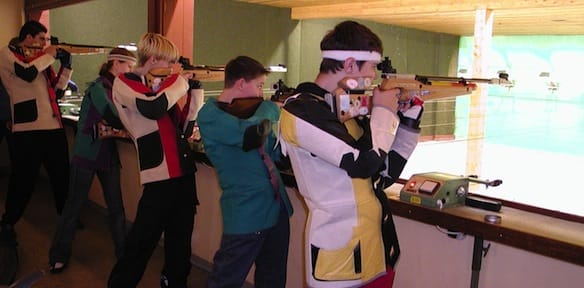
Image credit: Wikipedia.
Hunting Wabbits: Your Guide to Buying an Air Rifle
By Valerie Farabee
It is the winter of your discontent. You’ve had about as much fun as you can on your snowmobile, you’re about done with that ATV, you’ve checked out both cross-country and downhill skiing, you’ve snowshoed, and well, now you’re bored. When you’ve exercised what feels like all your options for winter fun and those dark days are still upon you, what more is there to do?
Take up shootin’, of course! In appreciation for all the hard work you’ve done to keep yourself fit, healthy, and outdoors during the winter time, Priceonomics has put together a guide on how to buy an air rifle – because we know you want to stay active during ALL seasons, and an air rifle will keep you company winter, spring, summer and fall.
What is an Air Rifle?
Let’s get the obvious out of the way first. It’s a type of gun. In this case, it is specifically a rifle – a gun designed to shoot from shoulder height, with grooves (‘rifles’) in the barrel designed to make your projectile of choice spin around to more accurately hit your target. An air rifle is one that fires projectiles using compressed air (or other gas) as opposed to a firearm, which fires projectiles using a burning propellant and is what you think of when I say “rifle”.
Plinkin’ and Pest Control
Air rifles are frequently used for small game hunting, pest control, plinking, and recreational sports. How you plan to use your air rifle – which of the above is your cup o’ tea – distinctly impacts the kind of air rifle you will buy. Is pest control your goal? Plain ol’ plinkin’? The same rifle you might use for casual plinking – which is recreational shooting, by the way, onomatopoeically named for the ‘plink’ sound a pellet hitting a tin can makes – is not the same rifle you would use for small game hunting. Consider the age and intent of the shooter when looking at different kinds of rifles.
Pellets, Propulsion, and You
Air rifles are categorized based on the type of propulsion system they use: CO2, Spring Piston, and Pneumatic styles.
A CO2 powered rifle uses compressed carbon dioxide cartridges to propel a pellet. There are several advantages to the CO2 powered rifle: they are quiet and easy to use, with no cocking or other force required between shots, and they are available in a number of different sizes. The disadvantages include limited power and a high cost per shot. Note, for those shooting outdoors: the fluctuation of CO2 pressure due to ambient air temperature can lead to unpredictability in accuracy and power, important knowledge for hunting or target practice.
Spring Piston powered rifles are the most common air rifle used by adults today, using a hefty spring and air piston as its propulsion mechanism. Known for their velocity, accuracy, and power, these rifles are ideal across a variety of shooting situations. A great choice if your primary use is hunting or plinking.
Pneumatic air rifles use any type of compressed air to propel the pellet. You can get either the familiar pump up rifle or the pre-charged rifle. Pump up rifles compress air using a pumping mechanism on the rifle. While easy and basic, the noise and movement that pumping the rifle makes is a distinct disadvantage to hunters. Pre charged rifles use a large reservoir of highly compressed air for propulsion. These rifles are powerful, highly accurate, and well made, and as a result are generally the most expensive air rifles on the market.
Of a Certain Caliber
The choice of caliber will depend on the intended use of the air rifle. You have four main calibers to choose from:
.177 is the most common caliber, and many rifles chambered in .177 can fire either BBs or pellets, but check with the gun manual to be sure if its either, or, or both. This caliber is good for cost-efficient plinking and rat control. The .177 boasts a flat trajectory, a high velocity, and good penetration of the target.
.22 is another common caliber, larger than the .177, its weight packing energy and punch making it great for small game hunting. It is slower and less accurate than the .177, but has more power.
.20 Though not as popular as it’s calibered cousins, many think that the speed and size of the .20 make it ideal for the air gun. This is another caliber that can be used for small game hunting.
.25 is the least purchased caliber of our selection. It’s primary use is for serious, dedicated small game hunters, so if you really aren’t hunting wabbits, you probably don’t need this caliber.
Ammo-cessorize
Although most air guns can fire steel BBs, pellets have less ricochet factor and thus are safer to use. Remember to check your gun manual to see what the maker wants you to use in its gun! Use the flat nosed Wadcutter pellet for target practice. The Domed or Round-nosed pellet is a great choice as an all around pellet, useful for plinking, target practice, or small-game hunting. Hollow point and pointed pellets are used almost exclusively for hunting, and not what you want to grab as a casual plinker!
A new shooter can find a solid air rifle for around $150, while a more experienced shooter might go for a more specialized air rifle, spending up to $3000 for high quality manufacturers. Factor the cost of pellets – $10 for 500 in many places – and any target or shooting range memberships in the total price of your gun.
Always remember to point the gun away from your face, pay attention to gun safety, and take care of your machine. Happy shooting!



